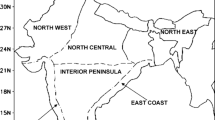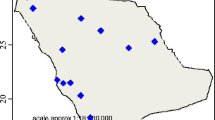Abstract
This paper examines the annual highest daily maximum temperature (DMT) in Korea by using data from 56 weather stations and employing spatial extreme modeling. Our approach is based on max-stable processes (MSP) with Schlather’s characterization. We divide the country into four regions for a better model fit and identify the best model for each region. We show that regional MSP modeling is more suitable than MSP modeling for the entire region and the pointwise generalized extreme value distribution approach. The advantage of spatial extreme modeling is that more precise and robust return levels and some indices of the highest temperatures can be obtained for observation stations and for locations with no observed data, and so help to determine the effects and assessment of vulnerability as well as to downscale extreme events.
Similar content being viewed by others
References
Beirlant, J., Y. Goegebeur, J. Segers, and J. Teugels, 2004: Statistics of Extremes: Theory and Applications. Wiley, N.Y., 514pp.
Blanchet, J., and A. Davison, 2011: Spatial modeling of extreme snow depth. Annals of Applied Statistics, 5, 1699–1725.
Buishand, T.A., L. de Haan, and C. Zhou, 2008: On spatial extreme: With application to a rainfall problem. Annals of Applied Statistics, 2(2), 624–642.
Caesar, J., L. Alexander, and R. Vose, 2006: Largescale changes in observed daily maximum and minimum temperatures: Creation and analysis of a new gridded data set. J. Geophys. Res., 111, D05101, doi:10.1029/2005JD006280.
Coles, S., 2001: An Introduction to Statistical Modelling of Extreme Values. Springer, N.Y., 224pp.
Cooley, D., J. Cisewski, R. J. Erhardt, S. Jeon, E. Mannshrdt, R.O. Omolo, and Y. Sun, 2012: A survey of spatial extremes: Measuring spatial dependence and modeling spatial effects. REVSTAT-Statistical Journal, 10, 135–165.
Cressie, N., and C. Wikle, 2011: Statistics for spatiotemporal Data. Wiley, Hoboken, 624pp.
Davison, A. C., 2009: A sketch of statistics of spatial extremes. A lecture note given at the Workshop on Spatial Extremes and Applications, EPFL, Lausanne, Switzerland. [Available online at http://extremes.epfl.ch/files/content/sites/extremes/files/users/111184/public/WorkshopJuly09/Davison.pdf.]
Davison, A. C., and M. M. Gholamrezaee, 2012: Geostatistics of extremes. Proc. Royal Society A, 468, 581–608, doi:10.1098/rspa.2011.0412.
Davison, A. C., S. A. Padoan, and M. Ribatet, 2012: Statistical modelling of spatial extremes (with discussions). Statistical Science, 27(2), 161–186.
DeGaetano, A., and R. Allen, 2002: Trends in twentieth century extremes across the United States. J. Climate, 15, 3188–3205.
de Haan, L., 1984: A spectral representation for maxstable processes. Annals of Probability, 12(4), 1194–1204.
de Haan, L., and T.T. Pereira, 2006: Spatial extremes: models for the stationary case. Annals of Statistics, 34, 146–168.
Durre, I., and J. M. Wallace, 2000: Dependence of extreme daily maximum temperatures on antecedent soil moisture in the contiguous united states during Summer. J. Climate, 13, 2641–2651.
Easterling, D. R., and Coauthors, 1997: Maximum and minimum temperature trends for the globe. Science, 277, 364–367.
Gaume, J., N. Eckert, G. Chambon, M. Naaim, and L. Bel, 2013: Mapping extreme snowfalls in the French Alps using max-stable processes. Water Resour. Res., 49, doi:10.1002/wrcr.20083.
Gholamrezaee, M. M., 2009: Diagnostic tools in spatial modeling of extreme values. A poster at the Workshop on Spatial Extremes and Applications. EPFL, Lausanne: Switzerland. [Available online at http://extremes.epfl.ch/webdav/site/extremes/users/.]
Hopkinson, R. F., D. W. McKenney, E. J. Milewska, M. F. Hutchinson, P. Papadopol, and L. A. Vincent, 2011: Impact of aligning climatological day on gridding daily maximum-minimum temperature and precipitation over Canada. J. Appl. Meteor. Climatol., 50, 1654–1665.
Hosking, J. R. M., and J. R. Wallis, 1997: Regional Frequency Analysis: An Approach Based on L-moments. Cambridge University Press, Cambridge, 244pp.
Jonathan, P., and K. Ewans, 2013: Statistical modeling of extreme ocean environments for marine design: A review. Ocean Engineering. 62, 91–109.
Karl, T. R., P. D. Jones, R. W. Knight, G. Kukla, N. Plummer, V. Razuvayev, K. P. Gallo, J. Lindseay, R. J. Charlson, and T. C. Peterson, 1993: A new perspective on recent global warning: Asymmetric trends of daily maximum and minimum temperature. Bull. Amer. Meteor. Soc., 74, 1007–1023.
Katz, R. W., 2010: Statistics of extremes in climate change. Climatic Change, 100, 71–76.
KMA, 2010: Abnormal Climate Extreme Special Report 2010. Korea Meteorological Administration, 114pp.
Kim M.-K., and S. Kim, 2011: Quantitative estimates of warming by urbanization in South Korea ove the past 55 years (1955–2008). Atmos. Environment, 45, 5778–5783, doi:10.1016/j.atmosenv.2011.07.028.
Lee, T. C., H. S. Chan, E. W. L. Ginn, and M. C. Wong, 2011: Long-term trends in extreme temperatures in Hong Kong and Southern China. Adv. Atmos. Sci., 28 (1), 147–157 doi: 10.1007/s00376-010-9160-x.
Lee, Y., S. Yoon, Md.S. Murshed, M.-K. Kim, C.H. Cho, H.-J. Baek, and J.-S. Park, 2012: Spatial modeling of the highest daily maximum temperature in Korea via max-stable processes. Technical Report, Dept. of Statistics, Chonnam National University. 34pp. [available at http://stat.jnu.ac.kr/bbs/zbxe/?mid=introPJS]
Li, H., T. Zhou, and J. Nam, 2009: Comparison of daily extreme temperatures over eastern China and South Korea between 1996–2005. Adv. Atmos. Sci., 26(2), 253–264.
Padoan, S. A., M. Ribatet, and S. A. Sisson, 2010: Likelihood-based inference for max-stable processes. Journal of the American Statistical Association, 105, 263–277.
Ribatet, M., 2009: A user’s guide to the spatial extremes package. [Available online at http://cran.rproject.org/web/packages/SpatialExtremes/vignettes/SpatialExtremesGuide.pdf.]
Shang, H., J. Yan, and X. Zhang, 2011: El Niño-Southern Oscillation influence on winter maximum daily precipitation in California in a spatial model. Water Resour. Res., 47, W11507, doi: 10.1029/2011WR010415.
Schlather, M., 2002: Models for stationary max-stable random fields. Extremes, 5, 33–44.
Smith, R. L., 1990: Max-stable processes and spatial extremes, unpublished manuscript. [Available online at http://www.stat.unc.edu/postscript/rs/spatex.pdf].
USCCP, 2008: Weather and climate extremes in a changing climate, 162pp.
Westra, S., and S. A. Sisson, 2011: Detection of nonstationarity in precipitation extremes using a maxstable process model. J. Hydro., 406, 119–128.
Yan, Z., S. Bate, R. E. Chandler, V. Isham, and H. Wheater, 2002: An analysis of daily maximum wind speed in northwestern Europe using generalized linear models J. Climate, 15(15), 2073–2088.
Yan, Z., S. Bate, R.E. Chandler, V. Isham, and H. Wheater, 2006: Changes in extreme wind speeds in NW Europe simulated by generalized linear models. Theor. Appl. Climatol., 83, 121–137.
Author information
Authors and Affiliations
Corresponding author
Rights and permissions
About this article
Cite this article
Lee, Y., Yoon, S., Murshed, M.S. et al. Spatial modeling of the highest daily maximum temperature in Korea via max-stable processes. Adv. Atmos. Sci. 30, 1608–1620 (2013). https://doi.org/10.1007/s00376-013-2216-y
Received:
Revised:
Accepted:
Published:
Issue Date:
DOI: https://doi.org/10.1007/s00376-013-2216-y




